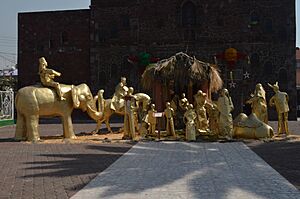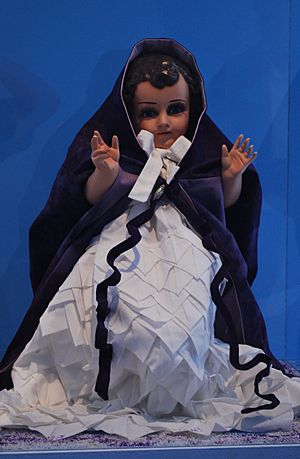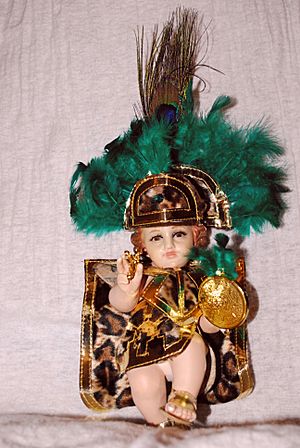Child Jesus images in Mexico facts for kids
The Niño Dios (which means Child God) is a special tradition in Mexico. It's about honoring the Child Jesus. This tradition started in the 1500s when the Spanish brought it to Mexico. Over time, it mixed with older Mexican customs, creating unique celebrations.
Mexican Catholics have their own statues of the Child Jesus. They honor and celebrate these statues during the Christmas season. The main celebrations happen on Christmas Eve and on Candlemas (February 2nd). A special Mexican tradition is to dress the statue in new clothes each year. This happens when the statue is taken to Mass on Candlemas. The outfits can be very different! They can look like saints, Aztec clothing, or even football players. Some Niño Dios statues are also famous locally and are honored all year long.
Contents
History of the Niño Dios
Honoring the Child Jesus is a European tradition. Famous examples include the Infant Jesus of Prague and the Santo Niño de Atocha. The Spanish brought this tradition to Mexico after they conquered the Aztec Empire. In Mexico, this tradition became very important and mixed with local customs. This happened partly because native Mexicans already had ways of showing their gods in art and statues. They also had special ceremonies for these figures.
One of the oldest traditions about the Child Jesus in Mexico is the "pastorela." This is a play about the birth of Jesus. The first "pastorela" in Mexico was probably "The Adoration of the Magi." Friar Andrés de Olmos organized it. It was written in Nahuatl, an ancient Mexican language. The play was changed to fit local culture. Juan de Zumárraga, the first bishop of New Spain, wanted these plays to be performed everywhere. This helped teach people about Christianity.
Over time, these plays changed based on local customs. They were often performed by everyday people. The main story is about the Three Wise Men traveling to Bethlehem. Demons often try to stop them! But usually, an angel like the Archangel Michael defeats the demons. Then, the Wise Men reach their destination. Characters in these plays often include shepherds, demons, angels, and the Wise Men. Sometimes, Mary, Joseph, and other local people also appear. At the end of the play, everyone kisses the statue of the infant Jesus.
Christmas Eve Celebrations
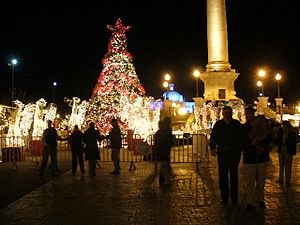
Honoring the Christ Child is strongest during the Christmas season. This season starts about a week before Christmas Eve with events called "posadas." It ends on Candlemas, February 2nd.
On Christmas Eve, families place the Christ Child statue into their Nativity scene at home. This event is called "put the child to bed." One or more young women carry the statue. The rest of the family sings lullabies or Christmas songs. Each family member kisses the statue as they sing. The statue is then placed in the manger. It stays there until February 2nd.
This ceremony can be different for each family or community. For example, in Dzitnup, a Maya community in Valladolid, Yucatán, they have their own version. Besides putting the child in the manger, they have a dance called "Abraham and Isaac." This dance includes people playing the two main characters and devils. A special ancient wind instrument called a "tunkul" plays music for the dance.
Another Christmas Eve tradition is for children to write letters to the Christ Child. They usually ask for things like toys and clothes.
Candlemas (Candelaria)
Candlemas, or Candelaria in Spanish, is on February 2nd. It marks the end of the Christmas season. Nativity scenes usually stay up in homes until this date.
Preparations for Candlemas can start on January 6th, which is "Three Kings Day." On this day, families share a ring-shaped sweet bread called a Rosca de Reyes. Inside the bread, tiny baby figures are hidden. The people who find these figures have special duties for Candlemas. They always have to buy tamales and drinks for the celebration. But it can also mean a bigger promise. The person chosen might need to buy an outfit for the family's Niño Dios for one, two, or even three years. They might also need to buy an outfit for the tiny figure they found.
Each year, the family's Niño Dios is taken to Mass on February 2nd to be blessed. After Mass, the family goes home to celebrate. They usually eat tamales, buñuelos, atole, and hot chocolate. This tradition reminds people that Mary and Joseph took Jesus to the Temple to present him to the priests forty days after his birth.
To present the Niño Dios at Mass, tradition says the statue must wear a new outfit. These outfits can be very different, but some are more popular. If it's the first year for a new statue, or if someone has promised for three years, the statue wears white. This color means purity. Other common outfits include the Santo Niño de Atocha (with a staff and sitting on a chair). There's also "Niño de las palomas" (Child of the doves) in a white robe with a dove. Some dress the statue as Saint Francis, with sandals and a brown robe, holding an animal. Or as "Niño de las azucenas" (Child of the lilies) in a white tunic holding lilies.
Because people need new outfits each year, a market for these clothes has grown. People start buying outfits as early as December and continue until February 2nd. The outfits can be simple and cheap, or fancy and made of silk. Most common outfits use silk, satin, cotton, and fancy fabrics decorated with silver or gold. Stationery stores often sell traditional outfits. But people usually buy them at open markets called "tianguis." Here, you can find more unique outfits. These might include different saints, ancient Mexican clothing, mariachis, soccer players, or clothes from other countries. You can even order custom outfits! Some priests prefer only white outfits and don't like the non-traditional ones.
At the Casa de Cultura Griselda Alvarez in Mexico City, there was an exhibit of twenty-four Niños Dios. They were dressed in many ways: as a fisherman, as the Pope, as the Archangel Gabriel, as the Sacred Heart, and as the Atocha. This collection came from La Casa de los Niños Dios Uribe. The statues varied in size, from very small to very large. Most were made of ceramic or wood.
Famous Niño Dios Statues
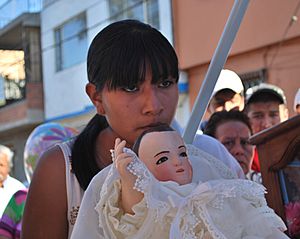
Besides the family Niño Dios statues honored at Christmas, some Child Jesus statues are honored all year. These special Niños Dios often have a very important place in Mexican Catholic worship. Sometimes, there have been disagreements over who gets to care for them. Most of the well-known statues are in Mexico City and central Mexico. People often offer toys or candy to these statues. This tradition is similar to ancient Mexican customs of offering things to the dead for the afterlife.
One of the oldest Niño Dios statues in Mexico is the Niño Cautivo (Captive Child). It is in the Metropolitan Cathedral. A Spanish artist named Juan Martinez Montañez made it in the 1500s. The cathedral bought it. But on its way to Veracruz, pirates attacked the ship and stole it! A large payment was made to get the statue back. Today, it is in the Chapel of San Pedro. People traditionally prayed to this statue when they wanted to be free from problems, especially money troubles. Since 2000, people have also prayed to the Niño Cautivo when a family member has been taken for ransom.
Another famous Niño Dios is the Niñopa (also called Niño-Pa or Niñopan) from Xochimilco. This statue is also from the 1500s. It first belonged to an indigenous leader. The name "Niño Pa" mixes the Spanish word for "child" (niño) with the Nahuatl word for "place" (pan). So, it means "child of the place." People say this statue visits people in their dreams at night. It also checks on the community's crops. Some people even claim to have found mud on the statue's shoes in the morning!
This statue has been kept in different families' homes for over 430 years. The family that hosts it for a year becomes its "godparents." Being a "godparent" for this statue is a huge honor in Xochimilco. Families sometimes wait fifty years, and the list goes until 2035! The host family prepares a special bedroom in their home for the statue for the year. Families who have hosted the statue in the past often have copies of the Niñopa.

It is said that this statue became invisible when government soldiers tried to take it during the Cristero War. People used to think the statue was made of orange tree wood. But in the 1970s, a finger broke off when the statue was dropped. It was then found to be made of "chocolín" wood. It was made in the workshops of Bernardino of Siena in the 1500s or 1600s.
The Niño de las Suertes (Child of Luck) is also very popular. The statue was made in the 1800s, but people started honoring it widely more recently. Two evangelists found the statue in the ruins of a hacienda in Tlalpan. They gave it to Archbishop Francisco Lizana y Beaumont. Many monasteries wanted the statue. So, the archbishop decided to choose by drawing lots. It is said that the statue favored the Convent of San Bernardo. This was because the nuns there had promised to live simply. This was confirmed by drawing the lots three times. In the 1800s, the statue was moved to Tacubaya when the convent was no longer a church property. This statue has a small skull near the infant's head. This skull first symbolized Jesus' future suffering. More recently, it has made this statue popular with people who follow certain folk beliefs.
In Tacuba, there is a statue called the Niño Futbolista (Child Football/Soccer player). Its real name is "Santo Niño de los Milagros" (Holy Child of Miracles). People believe it grants many miracles. It is kept in a glass case surrounded by toys. These toys are gifts from people who received favors. Every four years, when the FIFA World Cup is played, this statue is dressed in the uniform of the Mexico national football team. People hope Mexico will win the cup!
The Santo Niño Doctor de los Enfermos (Holy Child Doctor of the Sick) is in a side altar at the church of San Francisco de Asís in Tepeaca, Puebla. The statue is old, but people started honoring it more recently. It used to belong to a nun at a hospital in Mexico City. When the nun moved to Tepeaca, she brought the statue with her. She kept it with her as she treated sick people. This statue has had its own feast day at this church since 1961, on April 30th.
Other famous Niño Dios statues in Mexico City include the Niño Limosnerito (Little Beggar Child) in Colonia Santa Maria la Ribera. There's also the Santo Niño del Verbo Encarnado (Holy Child of the Incarnate Word) in Colonia Alfonso XIII. And the Santo Niño Mueve Corazones (Holy Child Who Moves Hearts) in Colonia Santa Tomás. This last statue is believed to have helped many people become Catholic. Outside of Mexico City, there are the Niño Jesús de la Salud (Child Jesus of Health) in Morelia. Also, the Niño Milagroso (Miraculous Child) in Tlaxcala. The Niño Cieguito (Blind Child) in Puebla is called that because it doesn't have eyes. And the Santo Niño de Atocha in Fresnillo is a local version of a Spanish statue.
See also
 In Spanish: Niño Dios de México para niños
In Spanish: Niño Dios de México para niños


